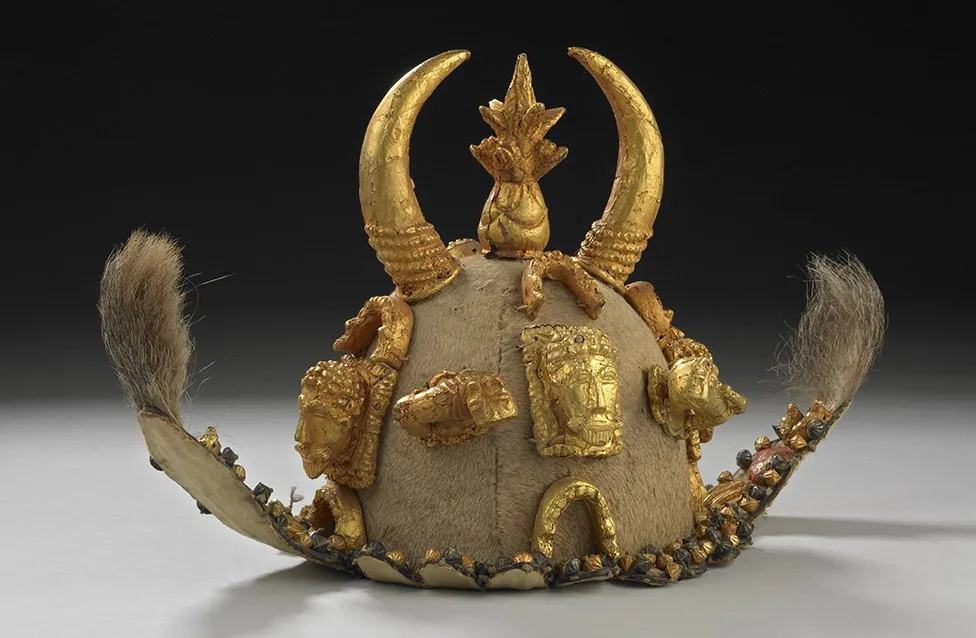For the first time in 150 years some of Ghana’s stolen gold and silver regalia belonging to the Ashanti Kingdom will make a return but not permanently.
The items are to be displayed at the Palace Museum in Ghana’s Kumasi city later this year but would be under a long-term loan commitment.
The Manhyia Palace Museum in Ghana with the Victoria & Albert Museum in London, and the British Museum made this announcement in a statement on Thursday announced the details what they call “an important cultural collaboration”.
Last year the Ghanaian monarch for the Asante people, Otumfuo Osei Tutu II visited London for the negotiations. Negotiations for this agreement lasted for nine months, the partners said.
The objects would be loaned, under separate agreements, to the Ghanaian Manhiya Palace Museum.
Some national museums in the UK – including the V&A and the British Museum – are banned by law from permanently giving back contested items in their collections.
A loan deals such as this is the only way to allow objects to return to their countries of origin.
Nana Oforiatta Ayim, special adviser to Ghana’s culture minister, was quoted by the BBC as saying that “They’re not just objects, they have spiritual importance as well. They are part of the soul of the nation. It’s pieces of ourselves returning.”
She said the loan was “a good starting point” on the anniversary of the looting and “a sign of some kind of healing and commemoration for the violence that happened”.
Details about the objects
The collection includes all 13 pieces of Asante Royal regalia acquired by the Museum at an auction in April 1874 of gold looted by the British army during the raid on and destruction of the royal palace on 4th-6th February, 1 gold peace pipe, 3 cast gold soul-washers’ badges, 7 sections of sheet-gold ornament, 1 silver straining spoon, 1 pair of silver anklets.
Also travelling to Kumasi are two further items of gold regalia bought by the V&A within a decade of the raid: 1 section of sheet-gold ornament purchased in 1874 from a military family and 1 cast gold soul-washer’s badge purchased in 1883 with no record of the previous owner.
Two further items include 1 gold ring given to us by a collector in 1921 and 1 gold ornament in the form of an eagle given by a military family in 1936.
These objects are of cultural, historical and spiritual significance to the Asante people. They are also indelibly linked to British colonial history in West Africa, with many of them looted from Kumasi during the Anglo-Asante wars of the 19th century.
The fifteen objects selected by the Manhyia Palace Museum from the British Museum include a small gold ornament in the form of a lute-harp (sankuo).
This ornament was one of the cast gold objects presented in 1817 to British diplomat Thomas Bowdich during his trip to Kumasi to negotiate a trade treaty with the Asantehene Osei Bonsu.
According to Bowdich, they were intended by the Asantehene as gifts for the British Museum and served as a means of representing the wealth and status of the Asante nation.
The inclusion of the sankuo highlights the long-term connections between the British Museum and the Asantehenes, now nearly 200 years old.
Other objects selected from the Museum include items of regalia associated with two of the 19th century Anglo-Asante wars (1873-4 and 1895-6), much of which was looted directly from the palace(s) in Kumasi and most of which formed part of the regalia of respective Asantehenes, Kofi Karikari (c.1837-1884) and Prempeh I (1870-1931).
Some of these formed part of a British indemnity payment forcibly extracted from the Asantehene at the time, while many others were sold at auction and later dispersed among museums and private collectors worldwide, including the British Museum and the V&A.
“The collections will form part of an exhibition planned to celebrate the 2024 Silver Jubilee of His Royal Majesty, the Asantehene, Osei Tutu II, as well as commemorating the 150th anniversary of the 1873-4 Anglo-Asante war and the 100th anniversary of the return of the Asantehene Prempeh I from exile in the Seychelles,” the statement said.
Source: Africafeeds.com


